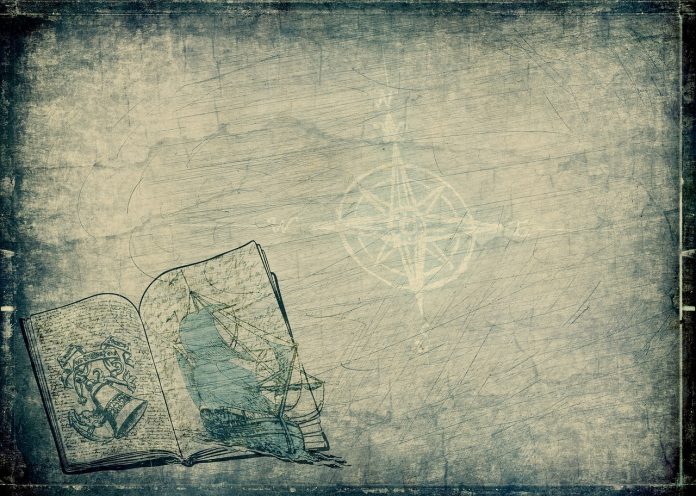Step into the past with our ‘Vietnam War Map,’ a succinct exploration that delves into the historical contours of the Vietnam War. Before we navigate the critical milestones, let’s set the stage: The Vietnam War, spanning from 1955 to 1975, was a complex conflict rooted in the struggle for independence and ideological differences.
This conflict, often considered a proxy war of the Cold War, witnessed the division of Vietnam into North and South, with the North led by the communist forces under Ho Chi Minh, and the South supported by the United States. The war unfolded against the backdrop of shifting alliances, geopolitical tensions, and a deep-seated desire for autonomy.
Now, let’s dive into the heart of our exploration, where the ‘Vietnam War Map’ will guide us through significant events, battles, and the evolving landscape of this turbulent period in history.
1954-1959: Geneva Accords
- 7/1954: The Geneva Accords was established. The agreement led to the end of French military presence on the Indochina peninsula and officially ended French colonial rule in Indochina. The warring parties agreed to a ceasefire and the restoration of peace across Indochina, took the 17th parallel as the temporary military boundary. The warring parties gather and move troops according to the prescribed area and time. Vietnam would be unified by a free election in July 1956 under the control of an international Commission, but it never happened.
- 1955: Ideological Warfare, and the Strained North-South Relations in Vietnam. Ngo Dinh Diem emerged as leader of South Vietnam, with the backing of the United States, while Ho Chi Minh led the communist state in the North. The southern government carried out psychological warfare propaganda activities based on the spirit of Christianity and defamed communism to call on the people of the North to migrate to the South. Meanwhile, on February 4, 1955, the Democratic Republic of Vietnam (North Vietnam) issued a declaration on the restoration of normal relations between the two regions, creating conditions for the people of the two regions to tighten economic ties. However, South Vietnam completely refused and in 1958 imprisoned over 150 Northern merchants sent to find trading partners.
- 1955-1956: The US sponsored 414 million USD to help equip the standing forces of the Republic of Vietnam army, accounting for 80% of the military budget of the Ngo Dinh Diem regime, helping the Republic of Vietnam to be able to maintain the administrative apparatus and army, replacing French tactics and weapons with American ones.
- 7/1956: General elections were not held. Ngo Dinh Diem resolutely refused to hold a national election. America wanted an anti-Communist government to exist in South Vietnam. In September 1960, after a peaceful political struggle to unify the country in the spirit of no results, North Vietnam officially supported the armed and political struggle activities of Viet Minh forces in the south of 17th parallel. Tensions escalate.
- 5/1959: Ho Chi Minh Trail. The North secretly conducted exploration and development of a strategic supply route: Truong Son Road – also known as the Ho Chi Minh Trail. This will be a strategic transportation route to ensure war needs will be expanded in the South later. Although at that time, this route was still just forest trails passing through Laos and Cambodia for liaison and officer teams going to the South. At the same time, the National Assembly of the Republic of Vietnam passed Law No. 91 called Law 10-59, the accused could be brought directly to trial without opening an investigation, the sentence had only two levels: death penalty or imprisonment. Hard labor, lasting 3 days maximum, without amnesty or appeal; Death penalty instruments include the guillotine. Communist forces suffered heavy losses.
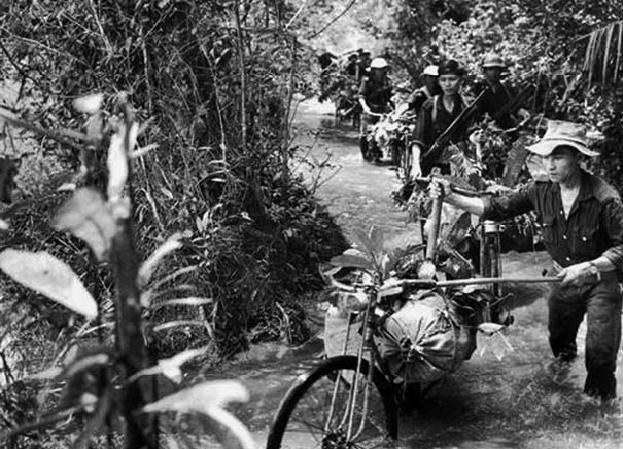
- 7/1959: First Americans killed in South Vietnam. The Military Assistance Advisory Group (MAAG) compound in Bien Hoa, a town about 20 miles (32 km) northeast of Saigon, was attacked by six Viet Cong soldiers. Major Dale R. Buis (visiting from MAAG 5) and Sergeant Chester M. Ovnand (MAAG 7) would be among the first Americans killed in the Vietnam War.
1960-1964: The beginning of the war, the end of the First Republic and Ngo Dinh Diem. “Special War” strategy.
- 9/1960: President Ho Chi Minh had poor health, Le Duan, an excellent student of President Ho Chi Minh, took over as general secretary of the communist party in North Vietnam. He outlined the revolutionary strategy in South Vietnam with his work “Outline of the Southern Revolution”.
- 12/1960: The National Liberation Front of the South (NLF) was established. The US considers the NLF a puppet of North Vietnam and calls it Viet Cong (short for Vietnam Cong-san, or Vietnamese communists), while the NLF claims to be an alliance of all parties and socio-political organizations in the South. And have a stance and sovereignty to control the struggle against the United States and the Republic of Vietnam. The force increased rapidly to about 300,000 people in early 1962.
- 5/1961: The Staley–Taylor Plan was announced. This plan aimed to use advanced tools and overwhelming weapons to pacify South Vietnam in 18 months, ensuring superiority for South Vietnam on the battlefield. Since August 1962, Ngo Dinh Diem announced: “Plan to establish strategic hamlets nationwide”, the establishment of strategic hamlets was raised to a “national policy”. The goal was to isolate the liberation army from the people, cutting off North Vietnam’s supply source. The US used mobile vehicles to launch sweeping operations to destroy communist forces, control gates and borders to block supplies from the North to the South. By 1965, the plan ended because it was no longer effective.

- 1/1962: Agent Orange. In Operation Ranch Hand, the US sprayed Agent Orange to destroy forests in Vietnam, Laos and Cambodia that provided shelter and food for guerrilla forces. This is a serious pollution disaster that remains in soil and water, causing many health consequences to this day.
- 2/1962: Bombing of the Independence Palace. Ngo Dinh Diem luckily survived the bombing of the Independence Palace. This can be considered a coup. The coup was first and foremost a matter of conflict between the Ngo Dinh Diem regime and the Vietnam Nationalist Party, and had nothing to do with Buddhism (as rumored).
- 1/1963: Battle of Ap Bac. In Ap Bac, a village in the Mekong Delta, the South Vietnamese army failed miserably when fighting Viet Cong forces, despite being four times more numerous and equipped with superior and superior equipment under their command. Coat of arms of the American advisor. This was the NLF’s first victory and boosted the NLF’s fighting spirit.

- 5/1963: Buddhist Crisis. Conflicts occurred when the South Vietnamese government discriminated against religions, favoring Catholicism while Buddhism is a traditional religion. During the shooting on a crowd of nonviolent protesters at the radio station, eight people died, including children. The prestige and trust in Diem’s government has since collapsed, the movement against Diem grew stronger.
- 6/1963: Thich Quang Duc. Monk Thich Quang Duc, 73 years old and highly reputable in Buddhism, burned himself in the middle of the city to protest Diem. The Buddhist movement has flared up throughout the country. America has lost all faith in Diem.

- 11/1963: The Coup. Under the support of the US, the coup took place by military generals, Ngo Dinh Diem and his brother Ngo Dinh Nhu died brutally, the First Republic collapsed. After the coup, from 1963 to 1965, the South Vietnamese government became increasingly unstable, with 12 governments led by successive coups replacing each other.
- 11/1963: President Kennedy is assassinated. Lyndon B. Johnson becomes president after President Kennedy is assassinated in Dallas, Texas. Vietnam war policy changed.
1964 – 1968: The “Americanization” of joint warfare in South Vietnam with a “Local War” strategy
- 8/1964: Gulf of Tonkin incident. The Gulf of Tonkin incident resulted in heightened direct U.S. involvement in the Vietnam War. This event includes two encounters: the first, confirmed to have happened on August 2, 1964, was initiated by North Vietnam forces in response to covert U.S. activities in the Gulf area. The second purported confrontation, believed to have occurred on August 4, 1964, involving U.S. vessels in the Gulf of Tonkin. The subsequent investigation showed that the second attack was allegedly fabricated by the US. Two American planes were shot down and one American pilot was captured by North Vietnam. Two American planes were shot down and one American pilot was captured by North Vietnam.
- 8/1964: The Gulf of Tonkin Resolution. The National Assembly passed the Gulf of Tonkin Resolution(or the Southeast Asia Resolution), which authorized the president to take all necessary measures, including armed force.
- 8/1964: Pierce Arrow. This is an action in response to the Gulf of Tonkin incident carried out by US Navy aircraft, attacking North Vietnamese naval bases in Lach Truong (Thanh Hoa), Bai Chay (Hon Gai). 2 American A-4 Skyhawk aircraft were shot down, 1 pilot was captured. Then the air war spread throughout Northern Vietnam, except for the two cities of Hanoi and Hai Phong due to concerns about international reactions.
- 11/1964: Help from the Soviet Union and China for North Vietnam. The Soviet Union increasingly sent North Vietnam a number of aircraft, artillery, radar, food, medical equipment, etc. Meanwhile, China sent engineers to establish air defense infrastructure in the North.
- 2/1965: Operation Flaming Dart. President Johnson authorized the bombing of North Vietnam, citing retaliation for the assault on Pleiku air base. This airstrike initiative marked the commencement of the inaugural U.S. campaign for aerial sabotage in North Vietnam.
- 3/1965: Operation Rolling Thunder. The three-year campaign aimed at bombing the North and the Ho Chi Minh Trail to help reduce aid to South Vietnam. Along with that, the US navy landed at Da Nang beach, the first US force to land on Vietnamese soil.

- 6/1965: Nguyen Van Thieu. While serving as an army lieutenant general, Nguyen Van Thieu was elected Head of State of the Republic of Vietnam, then became president in the 1967 election until just before his defeat by North Vietnam.
- 7/1965: President Johnson requested the deployment of an additional 50,000 ground troops to Vietnam, leading to an escalation in the draft to 35,000 individuals per month.
- 8/1965: Operation Starlite. The most prominent is Van Tuong Battle. The US killed 614 soldiers, captured 9 prisoners, detained 42 suspects and collected 109 types of weapons, at the cost of 51 deaths and 203 injuries, 22 tanks and armored vehicles, and destroyed 13 planes.
- 11/1965: Norman Morrison. Norman Morrison burned himself in front of the Pentagon to protest the Vietnam War, inciting an anti-war movement in the US.
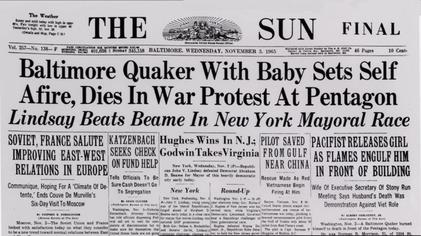
- 11/1965: La Drang Battle. This was the first large-scale battle, part of the Plei Me campaign, located near the La Drang River. American troops had to retreat by helicopter. Nearly 300 US soldiers died and more than 200 were injured, with dozens of tanks, aircraft and military vehicles damaged. The liberation army suffered more casualties. However, both sides declared victory.
- 1966: 400.000. The number of US troops present in Vietnam increased to more than 400,000.
- 6/1966: Bombing. The US dropped destructive bombs in the north and began destroying the infrastructure of Hanoi and Hai Phong
- 1967 : 500.000. The number of US troops present in Vietnam increased to more than 500,000.
- 1967 – 1968: The US dropped concentrated bombs on airports and seaports in Hanoi and Hai Phong, and North Vietnam fought back fiercely.
- 4/1967: Anti-war. Many anti-war protests took place in major cities such as Washington, New York and San Francisco.

- 10/1967: Nguyen Van Thieu was elected president of the Southern government.
- 11/1967: Operation DakTo – Tan Canh. In this battle, America suffered more damage than in any previous battles. The South Vietnamese Liberation Army announced that it had fought 57 battles, including 12 defensive battles, 5 combined offensive and key operations, 6 offensive operations, 15 artillery shelling, 1 ambush, 1 practice. Raid, an attack on the town. Nearly 2,000 American soldiers died or were injured, 3 airports were destroyed, serious damage was done to weapons and combat vehicles, many units were wiped out, including both the US side and the liberation army.
- 1-4/1968: Khe Sanh Battle. Khe Sanh is an area near the Vietnam – Laos border, strategically located close to the Ho Chi Minh Trail designed by the US to prevent reinforcements from North to South. North Vietnamese troops attacked and shelled for 77 days the American garrison here. The American garrison lost half of its troops, not to mention the three months that followed. Although the US was able to withstand the siege, it was forced to withdraw its troops under public pressure.

- 1/1968: Mau Than Tet Offensive. The liberation army and the people of the South led a general uprising in nearly 100 cities and bases throughout the South. The US Embassy was captured. The attacks were bloody and caused heavy damage to both sides. This was the turning point, the beginning of America’s withdrawal from the war.

- 2/1968: 543. From the 11th to the 17th, the week recorded the highest number of American soldiers killed, up to 543.
- 2 – 3/1968: Battle Hue & Saigon end. The US and its allies pushed back the liberation army from Hue and Saigon.
- 3/1968: My Lai Massacre. The My Lai Massacre, occurring on March 16, 1968, in Vietnam, was a war crime committed by the U.S. Army. An estimated 347-504 unarmed civilians, mostly women and children, were brutally killed. This event deeply shocked American and global public opinion, fueling the anti-war movement and influencing the decision to withdraw U.S. troops from Vietnam.

- 3/1968: President Johnson stopped bombing Vietnam north of the 20 th parallel and announced he would not run for re-election.
- 11/1968: Richard M. Nixon was elected president
- 5/1969: A Bia Battle. The US concentrated a force of nearly 2,000 troops under strong support from artillery fire to capture the hill (Mount A Bia). The hill was called Hamburger Hill. American troops took over after 10 days of fighting with 72 dead and 372 wounded and had to abandon this position a month later.
- 9/1969: President Ho Chi Minh dies in Hanoi.

- 12/1969: The initial draft lottery. The U.S. government implements the initial draft lottery since World War II, leading to an increasing number of young American men, later referred to as “draft dodgers,” deciding to seek refuge in Canada.
1969-1972: “Vietnamization of the war”
This is the period when the US gradually withdrew from the Vietnamese battlefield depending on the ability of the Republic of Vietnam army to personally ensure the war.
- 1969-1972: “Vietnamization of the war”. The number of American troops decreased from 549,000 in 1969 to 69,000 in 1972.
- 2/1970: Paris Negotiations. Henry Kissinger and Le Duc Tho had secret peace negotiations in Paris.
- 3/1970: Cambodia. The US supported Lon Nol in deposing Prince Norodom Sihanouk, who had previously supported North Vietnam in allowing the transport of goods at the border. However, in 1971, this force was defeated by the Khmer Rouge and the southern liberation army, opening up a large rear area for war, which was America’s mistake.
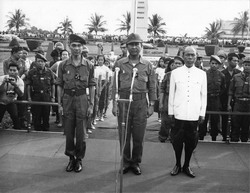
- 3/1969 – 5/1970: Operation Menu. The US used B-52 aircraft to bomb Cambodia because it suspected communist bases and camps. The plan was initially kept secret because Cambodia was neutral in the war, but was later revealed.
- 4/1970 – 6/1970: The United States and southern forces attacked communist bases close to the Cambodian border.
- May 4, 1970: Kent State Shooting. In a bloody incident known as the Kent State Shooting, National Guardsmen fired on anti-war protesters at Kent State University in Ohio, killing four students killed and 9 people were injured.
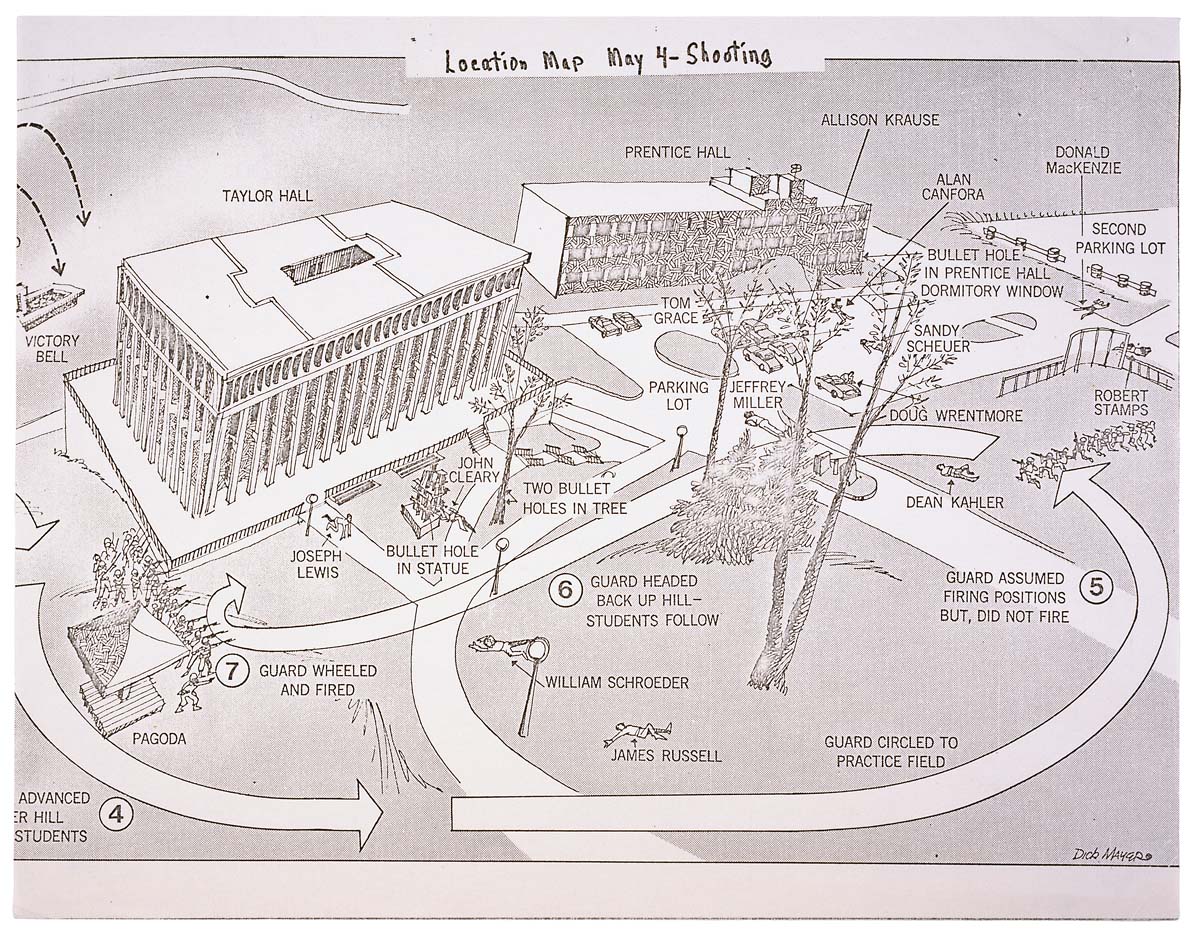
- 6/1970: The Gulf of Tonkin Resolution was repealed.
- 1 – 3/1971: Operation Lam Son 719. The Army of the Republic of Vietnam, supported by the US Air Force, attacked Laos to cut off the Ho Chi Minh Trail. This is also the US’s test of ARVN’s independent combat ability. The US and ARVN had to withdraw their troops and suffered heavy losses.
- 6/1971: The Pentagon Papers. The New York Times releases a series of articles disclosing leaked Defense Department documents related to the war, commonly referred to as the Pentagon Papers. The documents expose that the U.S. government had covertly and consistently escalated U.S. participation in the war.

- 3-10/1972: Easter Offensive. Large-scale attack targeting ARVN and US forces. North Vietnam’s scope of control was expanded, but this was not North Vietnam’s decisive blow.
- 5-10/1972: Operation Linebacker. This was the largest air attack since the beginning of the war, when most of North Vietnam’s air defense forces were mobilized into the South. The attack used many tactical aircraft accompanied by a number of B-52 s, focusing on bombing Hanoi and Hai Phong with about 20,000 tons of bombs, along with torpedo attacks on Hai Phong port.
- 12/1972: Operation Linebacker II. This was the last US military campaign against North Vietnam, due to the deadlock in the Paris agreement, a continuation of the Linebacker campaign. The biggest difference is that the US attacked with the most modern aircraft: B-52 instead of tactical aircraft, the propaganda purpose was “Bringing Vietnam back to the Stone Age”. In 12 days, the US dropped more than 36,000 tons of bombs, exceeding the volume of bombs dropped on North Vietnam during the entire period from 1969 to 1971. Northern infrastructure was heavily damaged, but the US Dozens of B-52 aircraft and dozens of other aircraft were damaged, nearly 100 in total. The damage was so great that the US had to make concessions in the Paris Agreement.
- 1/1973: Events in America. Former President Johnson dies at age 64. In Texas. US announced the end to the draft and instituted an all-volunteer military.
- January 27, 1973: President Nixon signed the Paris Peace Accords, ending direct US involvement in the Vietnam War. The US and North Vietnam ceased fire, but after that the war still existed under US sponsorship of the Republic of Vietnam and North Vietnam’s sponsorship of the liberation army.
- 2-4/1973: Operation Homecoming. North Vietnam returns 591 American prisoners of war (including future U.S. Senator and presidential candidate, John McCain)
1973-1975: End
- 8/1974: President Nixon resigned after the Watergate Scandal. Gerald R. Ford became president.
- 1/1975: President Ford rejects the possibility of additional U.S. military engagement in Vietnam.
- 3-4/1975: 1975 Spring Offensive. This was the last military attack in the Vietnam War. With the support of the Southern people, the liberation army launched a general attack on all fronts. The Army of the Republic of Vietnam fell and fled. On April 30, 1975, the liberation army entered Saigon and the Southern Government surrendered. In 18 hours, helicopters and planes of all kinds, along with ships of the US Navy, carried out a large evacuation from Saigon.
- 7/1975: UNIFICATION. Vietnam was officially unified to become the Socialist Republic of Vietnam, under the leadership of the Communist Party. The Vietnam War has ended.
